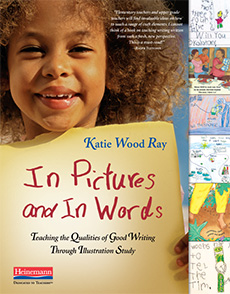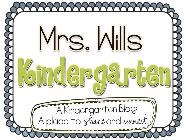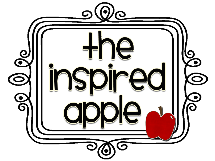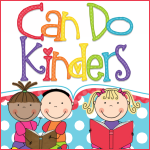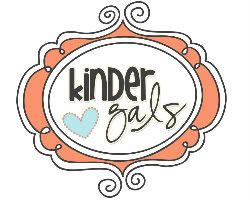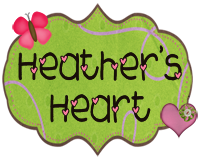My Book Study Blogging Comments:
In Pictures and In Words by Katie Wood Ray
Chapter 1: Why Illustration Study Matters to the Development of Young Writers
As Katie (the author) was setting the stage for the book, she described how one of her students, named Clay, felt about his work in his new illustration focused Writer’s Workshop. I quote.. “Clay truly seemed to relish thinking about ways he could engage and inform his readers as he made books about topics he knew a lot about.”
This quote really hit home with me…because that is exactly how I feel as a teacher who LOVES my job….and that’s how I want my student’s to feel about their “work.” I think about my class, planning, and how to best teach my kinder-kiddos pretty much 24/7…not because I “have to”…but because I LOVe it! It’s a challenge and a joy for me to problem solve on challenging kiddos and plan fun, crazy-fun lesson activities. My goal is to pass that “love of learning” on to my students. I want every child in my class to feel like Katie’s “Clay.”
Another point that I really valued in this chapter was how Katie appreciates the value of “developmentally appropriate” practices. “Teaching into illustrations” (allowing students who are not ready to begin WRITING instruction to learn the same skills through the study of the illustrations) fits perfectly with this. I agree with the point that “play is an important vehicle for developing self-regulation as well as for promoting language, cognition, and social competence.” (pg 10) Teaching “into” illustrations can be done in ways that are so fun, engaging and playful…that students truly enjoy the learning process. I know that I always strive to construct my lessons plans and activities around this key point. If you don’t know me well enough yet, you will soon learn through by BLOG that I’m BIG into incorporating technology into my lessons. I am excited to begin brainstorming how to integrate technology into “teaching into illustrations.”
Chapter “Love It” Quote! – Pg. 16 – “The forward-looking nature of teaching into illustrations asks teachers to understand that the world these children live in—and will ultimately grow to be effective communicators in – is a world where the definition of text will be greatly expanded: what it means to compose a text will go far beyond composition with words only.”
n So why would we teach a text only approach then? Let’s think about 21st century skills!
n We need 21st century literacy skills! It’s not just about “written” words in books anymore!
Chapter 2: Building Stamina for Writing by Supporting Children’s Work as Illustrators
Katie further supports “Teaching INTO illustrations” in this chapter with this quote from Tom Newkirk, “…A more accepting and supportive attitude toward drawing can keep some reluctant writers engaged with literacy, connected to the visual models they love.”
Woo-Hoo! I TOTALLY agree! It’s all about “scaffolding.” {Reading Recovery terminology} <-- gotta love ya’, Marie Clay!! (Can u tell I used to be a Reading Recovery teacher?!)
It’s our job as teachers to our kinders to become writers by moving from “nothing to something” as Katie would say! Each child is different. When they come to us, some may already be prepared to write in words…but others may only be ready to start with pictures. Let’s look at each child where they come in…and “scaffold” and support them where they are…and up to the next step!
Another great Chapter 2 point: “The CURRICULUM OF TIME!”
· students must be taught how to sit down in chairs, stay there for a long time, and make some work for themselves that leads to writing! (pg 21)
· students have to learn how to make “something out of nothing”
· AND… come back the next day and do it again!
· We must teach our kiddos to be both “the boat AND the wind” <-- I’m thinking we need a visual here Peeps! -- This means kids need to both show up (be the “boat”) and move themselves forward! (be the wind!)
Katie goes on to point out that “Worksheet Teachers” are training kids to do work that is laid out for them…and they are NOT required to THINK or use higher level skills. While these worksheet tasks may hold some value…they do NOT teach kids how to move themselves forward in school work…OR…in LIFE!)
Note that research shows that most of the jobs of the future will be project geared jobs… and for to be successful…children will been both the stamina to work on something for a long period of time, return to it day after day, and also to figure out how to move themselves forward! <-- Bigger picture, Peeps!
SIDE NOTE!!! I worked intensely on intentionally teaching stamina last year in my Reader’s Workshop. It takes TIME… and PATIENCE!!! But the results are OH SO WORTH IT! Back breaking work in Aug, Sept. Oct…makes life in Jan, - June a walk in the clouds! Teach self-regulation NOW… and watch your kiddos SKYROCKET second semester!
Katie stresses how “Picture Writing Books” invite stamina – Gotta love OFFICE DEPOT and their sweet, sweet binding skills! (Getcha’ a STAR teacher card!!!)) Those picture/writing books are the SINGLE BEST, MOST IMPORTANT material/tool I have ever purchased for my students!!!! (And I mean…if I was stuck on a desert island kind of good!)
“Love it” Quote for Chapter 3:
“Children can’t live on purpose if they aren’t ever allowed to follow their purposes.”
That quote is just another reason I love “PBL” projects (Project Based Learning)! (More about PBL in future posts!) I LOVE activities that foster self-regulation! That’s the KEY to life people! Yes, we need to teach our kids these “skills”…but we more importantly need to teach our kiddos to think for themselves, move themselves forward, and create their own futures! KWR (Katie Wood Ray) is a genius!!!)
Chapter 3: Writing and Illustrating as Parallel Composing Processes
I think I hear music… you know…like the voices of an angelic choir singing, every time I read the title to Chapter Three… WRITING AND ILLUSTRATING AS PARALLEL COMPOSING PROCESSES.
And as that angelic melody floats in the recesses of my mind…the hipster-teacher voice inside my brain (the one that uses trendy phrases in a voice that is much younger than my chronological age) says something like, “WHA? Did someone just figure out how to teach kiddos a required skill…. However, do it in a way in which you are actually teaching a widely “generaliz-able,” essential learning strategy…that can be shared with students so that when mastered, they can apply it to parallel learning processes in the classroom…and WAIT, WHAT?... That strategy can actually be applied in other areas of their REAL life as they grow up into adulthood to ensure a successful life!?! Woo-Wee! I gotta get me some of that!
Ok. Ok. So maybe ya’ all weren’t quite that excited…and I’m sure my “Reading Recovery Teacher” roots are showing on that comment…but the truth is, I LOVE, LOVE, LOVE when I find a way to connect the learning process of one area…as a parallel to a different process. If we, as teachers, can understand how all of these learning processes are connected…we can learn to teach these skills in smarter, more efficient ways…that yield in much better student retention and success…all the while making our jobs much less complex. And in the time crunched, high-expectation, test-pressured day that we live in…we ALL need to learn how to teach SMARTER…and plan Efficiently!
It is SOOO true that “what’s important to understand…is how the process of illustrating is just like the process of writing, and how forward-thinking teachers can support children’s growth as writers by simultaneously nurturing the process of illustrating.” (pg. 40)
Seriously, we all know as Kinder-Teachers that we ALWAYS have those kids who come in and do not possess all of the necessary skills to start “writing.” Even after the first month or so of foundation building, there are those little kiddos that just seem to lag behind the curve. They hold us back from “moving ahead” with more complex writing skills instruction…or perhaps we move ahead with text writing instruction, secretly knowing that our lessons will be sailing above their heads. IF we teach INTO illustrations…we can be successfully teaching for both processes, text composing and illustration composing, at the SAME time! It’s “differentiated instruction” in a whole group lesson!
Chapter “LOVE IT” Quote:
“Creating a climate of fearlessness about both writing and illustrating in the workshop is key to children growing as meaning-makers. Children need to know that if they can imagine it, they can try it… and trying it is what will be celebrated!” Pg. 50
My Class Motto: Kindergarten is for learning! Are we perfect? NO! We are just trying…and trying to do our best!
n Aren’t the bullets on pages 50 and 53 THE answers to the common core standard on “why are illustrations important in a story?” Woot-Woot! Gotta say… that was one of the questions that I received “weaker” student responses on this past year! BING!
Another Quote I LOVE… “He’s not an expert at all the techniques he’s trying – expertise will come with experience…” He is trying! He is being the wind in his own sails!!
Chapter Four: Teaching an Essential Habit of Mind: Reading like Writers in the Context of Illustration Study
Points I appreciated from this chapter…
- pg. 57 – By teaching students to look at illustrations with “insiders’ eyes”, you can teach them the exact same habit of mind writers engage in as they read.
- BTW.. “Game knows Game”… isn’t that why we all love TPT so much?!
“Once students learn to read as writers, then every act of reading has the potential to deepen their understanding of the craft of writing too.” Pg. 61
“Teaching students this habit of mind also fosters independence in them as they can be learning about writing whether their teachers are there or not.” <-- Isn’t this our goal!
“ The teaching context is deliberately designed so that children see themselves as being the same kinds of people as the authors and illustrators of the picture books that surround them in their classroom.”
Feel Good Point! Pg. 62 “The teacher’s role is to ensure the literacy club exists and that every child is in it.” In my classroom, we almost always do “Author’s Chair” daily! We ARE real writers and illustrators!! The kiddos get to enjoy the spotlight!
n As teachers we need to help them think about WHY illustrators/writers do certain things…because purposefulness should be our goal! (pg 64)
n Everything they see and consider becomes a possibility for future books they make, (pg 65)
Chapter Five: Learning Qualities of Good Writing from Illustration Techniques
Major Chapter Points:
- Understanding the Quality of Tone in Writing: Using careful word choices, deliberate sentence structures, and well-timed paragraph breaks, writers can strike a tone in a text that is humorous, somber, etc…
- Understanding the Quality of Tone in Illustrating: using color choice, shapes, line size, etc, focus, clarity, etc.
Chapter “LOVE IT“ Quote – pg. 72 – Learning and development are most likely to occur when new experiences build on what a child already knows and is able to do and when those learning experiences also entail the child stretching a reasonable amount in acquiring new skill, abilities or knowledge. (NAEYC).
!! Build on what a child already knows and is able to do!!
KWR: “By simply changing the way I think and talk about the decisions of illustrators in picture books, I now see enormous potential for helping children come to own so many important understandings about the craft of writing, but to know them first in the context of illustrations.”
Chapter Six: Planning and Implementing a Unit of Study in Illustrations
Check this out!! I love this quote: “If a curriculum is truly learning-centered, then that curriculum is based on inquiry and the search for questions that matter to us, whether we are adults or children. The function of curriculum is to support us in the inquiry process of searching for questions and ways of looking at those questions. Without inquiry, a sense of purpose and meaning in learning is lost and our natural inquisitiveness as learners is deadened.” Kathy Short and Carolyn Burke, Creating Curriculum: Teachers and Students as a Community of Learners
* Gotta love “learning-centered!” -- Anyone out there do any great “PBL” (Project Based Learning Projects that focus on inquiry based, learning-centered activities! I’d LOVE to chat about them!)
Pg 79 – Love the explanation of the difference between a “unit” and a “unit of study”…
· In a pre-planned unit, students are recipients of curriculum
· In a “unit of study,” students are active co-creators of curriculum.
J A “Study” has to have “study” in it!
The Predictable Framework for study in the Writer’s Workshop:
1. GATHER a stack of texts that are good examples of what I want to study.
2. Make sure students know what it is we’re studying and that I EXPECT them to write under the influence of this study.
3. IMMERSE ourselves in reading and talking about the gathered texts and what we notice about how they’re written.
4. STUDY some of them closely until we’ve become articulate (and can chart) about how people write this kind of text.
5. WRITE (both teacher and students) something that could go in the stack of texts we’ve been studying and be articulate about how our writing fits in the stack.
**The teaching practices, in different studies across the year, should be familiar and predicable. This is essential! They understand the process and take ownership.
“LOVE IT” PAGES: “Utilizing the Framework for Illustration Study” Pages 80 – 87
The section is explicit enough to help you get started with illustration studies in your classroom!
Inspired to JOIN US now? Simply click on the picture link to learn how to join us!
